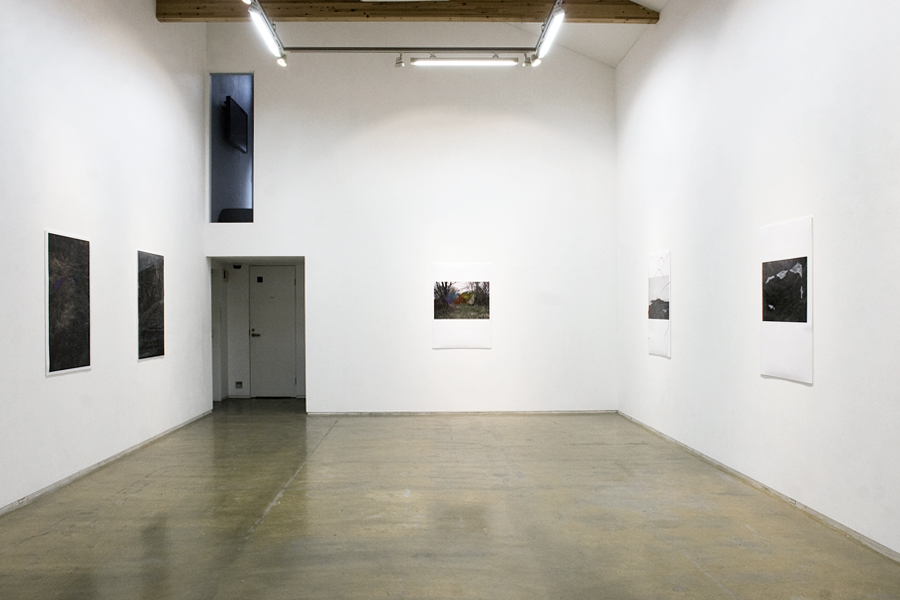Inagaki recalls his childhood memory of going for night fishing. Sailed to tetrapod and cast the fishing line. Inagaki was not so interested in fishing, so sailed around on the rubber boat by himself and accidentally went out to the open sea from tetrapod. At that moment he felt wide spreading depth of darkness in front of and bottomless ocean that left him a strong impression. He may have felt dark world or existence of death right next to him through his skin. Since ancient times, darkness and light have appeared as important theme of many tales and mythologies in various cultures and religions. Often darkness and light are used as metaphors of life. Twilight time when day and night are crossing is sometimes being afraid as devil’s time. In Japan, it has been thought as “time to meet devils” or “time for disasters” recognized as “time that we may encounter something mysterious such as Yokai (Japanese monster) or ghost” or “especially ominous time”. Inagaki himself is also afraid of some status changings and feels anxious in twilight and dawn time.
Inagaki perceives that sort of creatures of unknown nature and finds what he is seeing, other half hidden existence beyond what he is seeing, darkness and death and tries to capture them by cutting off unnecessary elements. For instance, he visits the same place many times to observe and captures in photography and video. Through his production process with untiring zeal, each experience was piled to draw a map to reveal a mystery gradually, step by step. Although he uses familiar and daily images, Inagaki’s drawings are raw and somehow gives us disquieting feelings because there are “darkness” and “death” behind them as mentioned earlier. Also because the things expressed are still in transition with indications and still changing the world, not fixed and completed. The word “sequence” nicely describes this sort of Inagaki’s stance for production. In other words, by using various methods, Inagaki expresses and continuously tries to secure a moment when something is changing into an other thing, unstable and amphibolous existence that is not decided to one complete thing yet.
In Inagaki’s artworks, specific motifs are not drawn. Even if some specific shapes could be seen, it still is something with abstractness. He has this basic attitude for photography and video arts also, note limited to drawings. Inagaki carefully observes his surrounding situations and tries to secure both what he visually sees and does not see, which consists the other half of the world that is the darkness side. Some mysterious being enters our minds and stay when we think of things invisible- half of the things actually ruling the world could be that sort of invisible dark side, which cannot be explained by words. An attempt to reveal what it is does not explain and still remains as mystery that cannot be completely understood. Inagaki tries to capture this undigested “something” into his body. For example, he tries to capture abstract things such as the meaning of living, dying and world after death and images keeps on expanding like word association game. Just as Inagaki said “Regardless of the material or method, I would like each artwork to have the save weight”, quality of expressions on each artworks can be recognized as the same. What is expressed here is “existence of nonexistence” or “in between nonexistence and existence” therefore his production could be said as a process of capturing “the traces of the dead left the bright daytime world ” which is the darkness.
Akiko Kasuya(Professor of Fine Arts, Kyoto City University of Arts)
稲垣元則 ― 観察の連続、闇を捉える
稲垣元則はドローイング、写真、映像など様々な技法を用いながら、周囲の事象を観察し、物の背後にあるかすかな気配を抽出する手法を継続的に展開してきた。制作活動の初期、まだ大阪芸術大学在学中の1992年から94年にかけて、自身の表現方法を模索するうち、B4のコピー用紙にドローイングするという現在まで続く制作スタイルを考案した。コピー用紙は身近で安価な素材であり、制作にも気軽に取り掛かることができるほか、サイズも比較的小ぶりであることから表現にたどり着くまでの障害もより少ないため、この技法は平易で親密な方法のやり取りを継続しやすい。稲垣はこのB4の用紙を縦に使い、極めて象徴性の高い表現によって、それぞれの周囲の事象を観察し、心に残るある状況のエッセンスを抽出するように要素をそぎ落としつつ、物事の核心に迫るという、ドローイングによる表現をそれ以後も追求し、また平行して写真や映像を使った表現にも積極的に取り組んでいる。
稲垣の子どもの頃の思い出で、夜釣りに連れて行ってもらったことがあったという。ゴムボートでテトラポットのところまで出かけて釣り糸を垂らす。稲垣自身はさほど釣りに興味がなかったため、一人でゴムボートに乗って、周囲をぐるぐる漕ぐうちに、テトラポットの外海に出たタイミングがあった。その際の、眼前に広がる闇の深さと、底知れない海の姿とが強く印象に残っているらしい。自分とすぐ隣合わせにある、闇の世界、あるいは死というものの存在を肌で感じた、ということかも知れない。古来、多くの文化や宗教において、闇と光は重要なテーマとして多くの物語や神話にも登場してきた。闇と光はしばしば死と生の比喩として用いられる。昼と夜とが交代する黄昏時は魔の刻として恐れられることも多く、日本でも「逢魔時」や「大禍時」つまり「妖怪や幽霊など怪しいものに出会いそうな時間」、「著しく不吉な時間」などと考えられてきたが、稲垣自身も、何かの状態が移り変わることに恐怖を覚え、特に夕暮れや夜明け時には不安に襲われるという。
稲垣は、そうした正体のわからないものの気配を感じ取り、その時自分が一体何を見ているのか、見えているものの背後に隠れたもう半分の存在、闇や死を見出し、それを掴もうとして、不要な要素をそぎ落としてゆく。例えば同じ場所を何度も訪れてそこを観察し、写真や映像におさめたり、繰り返し、たゆまず制作を続けたりする過程で、それぞれの経験が蓄積されて地図となり、段階を追って少しずつ謎は明らかにされる。身近で日常的なイメージを用いながらも、どこか稲垣のドローイングは生々しく、また不穏な気持ちを掻き立てられるのだが、それは上述のような「暗闇」や「死」が背後に潜んでいるからでもあり、そこで表現されているのがある固定された完成形ではなく、その前後左右に継続してゆく世界を含んでの、それらを予感させる移行状態であることにもよるのだろう。「シークエンス」という単語は、まさにそうした稲垣の制作姿勢をよく示すものである。すなわち、あるものから別のものへと状態が移り変わる瞬間、不安定な、まだどちらでもないものの両義的なあり方を、稲垣は様々な手法を用いながら表現し、定着させようと挑み続けているのだ。
稲垣の作品には、具体的なモチーフが描かれているわけではなく、たとえ具体的な形が見てとれるような場合があるとしても、それは抽象性を帯びる何か、である。狭義のドローイングだけでなく、映像や写真等の技法を用いた場合にも、この基本姿勢は変わらない。稲垣は、自らを取り巻く状況を静かに注意深く観察し、目の前に実際に見えているものと、見えないもの、世界の半分を占める暗闇の世界という、その両方を定着させてゆこうとしている。目に見えないものに思いを馳せた時、心に入ってきてそのまま中にとどまっている曲者―実際に世界を動かしているものの半分は、そうした目には見えない暗闇の部分、言葉では説明しがたい何者かであるのかも知れない。それを明らかにしようとしても、どうしてもわかりきれない謎として残り続ける。この消化しきれない「何か」を、稲垣は人の体の中に入れようとする。例えば生きること、死ぬこと、死後のことなど抽象的で捉え難い概念を彼は何とか捉えようとし、イメージのしりとりのように、繋がりを広げてゆく。素材技法が異なっても、「同じ重さにしたい」という稲垣の言葉通り、各作品に表現されているものの質は同等と考えることができる。ここで表現されているのは「不在の在」あるいは「不在と存在のあわい」であり、制作は「昼間の明るい世界から退いた死者たちの痕跡」、すなわち闇を捉える作業と言えるだろう。
加須屋明子 Akiko Kasuya(京都市立芸術大学美術学部教授)

←
←
motonoriinagaki.com
Copyright © 2012 Motonori Inagaki All Rights Reserved.